| KILLER CRUSTACEANS |
| Skeleton Shrimp |
| Phronima sedentaria |
Look at that face (if you can find it) and tell me you're not already intimidated. You're
fortunate this predatory amphipod is only an inch-long horror confined to the deepest
abyssal depths, and particularly fortunate that you aren't a salp; a gelatinous, filter-feeding
animal related to the tunicates.
fortunate this predatory amphipod is only an inch-long horror confined to the deepest
abyssal depths, and particularly fortunate that you aren't a salp; a gelatinous, filter-feeding
animal related to the tunicates.
| Pistol Shrimp |
While they don't look particularly unusual as far as shrimp are concerned, the pistol or
"snapping" shrimps have one of the most impressive biological weapons in the animal
kingdom. When the oversized claw is snapped shut, a tiny cavity is created in the water that
instantaneously collapses with incredible speed. This tiny implosion is nearly microscopic
and exists for barely a microsecond, but produces momentary nuclear fusion with
temperatures comparable to the surface of the sun itself. The final result is a concentrated
sonic blast, one of the loudest sounds in the ocean, that can paralyze or even kill the
shrimp's prey at close range.
"snapping" shrimps have one of the most impressive biological weapons in the animal
kingdom. When the oversized claw is snapped shut, a tiny cavity is created in the water that
instantaneously collapses with incredible speed. This tiny implosion is nearly microscopic
and exists for barely a microsecond, but produces momentary nuclear fusion with
temperatures comparable to the surface of the sun itself. The final result is a concentrated
sonic blast, one of the loudest sounds in the ocean, that can paralyze or even kill the
shrimp's prey at close range.
| STOMATOPODS |
Although the Caprellids are far more similar to an actual mantis, the Stomatopods are
commonly called "mantis shrimp" for their bulging eyes and scythe-like talons. These dazzling
carnivores are far more formidable than any mere insect, however. While some species are
"spearers" who impale prey on their thin, barbed sickles, others are classified as "smashers"
with more club-shaped appendages. The latter are adapted for cracking apart snails, fellow
Crustacea or even corals, and can do so with literally the force of a gunshot. To be precise, a
smasher can strike with around the force of a .22 caliber bullet; enough to punch a hole in
human bone. Even if it misses with its initial strike, the speed of the attack creates a similar
effect to the Pistol Shrimp's claw, not quite as refined but still quite devastating to other small
animals, essentially striking once with the claws themselves and again with their shock force.
commonly called "mantis shrimp" for their bulging eyes and scythe-like talons. These dazzling
carnivores are far more formidable than any mere insect, however. While some species are
"spearers" who impale prey on their thin, barbed sickles, others are classified as "smashers"
with more club-shaped appendages. The latter are adapted for cracking apart snails, fellow
Crustacea or even corals, and can do so with literally the force of a gunshot. To be precise, a
smasher can strike with around the force of a .22 caliber bullet; enough to punch a hole in
human bone. Even if it misses with its initial strike, the speed of the attack creates a similar
effect to the Pistol Shrimp's claw, not quite as refined but still quite devastating to other small
animals, essentially striking once with the claws themselves and again with their shock force.
With over a million described species and potentially tens of millions more, the class Insecta
comprises the vast majority of known organisms and the very foundation of most terrestrial
ecosystems, practically ruling our planet with a tiny, chitinous fist. And yet, with the exception
of a few obscure fly larvae, insects are virtually absent from the salty seas that cover most of
our planet and house the bulk of its biological mass. The reason for this, to put it in very simple
terms, is that the Crustacea were there first. Crabs, lobsters, barnacles, isopods and shrimp
are just a few major examples of this ancient subphylum, which dominates our vast oceans
with barely 5% as many species as their six-legged sisters on land.
Let's find out how!
comprises the vast majority of known organisms and the very foundation of most terrestrial
ecosystems, practically ruling our planet with a tiny, chitinous fist. And yet, with the exception
of a few obscure fly larvae, insects are virtually absent from the salty seas that cover most of
our planet and house the bulk of its biological mass. The reason for this, to put it in very simple
terms, is that the Crustacea were there first. Crabs, lobsters, barnacles, isopods and shrimp
are just a few major examples of this ancient subphylum, which dominates our vast oceans
with barely 5% as many species as their six-legged sisters on land.
Let's find out how!
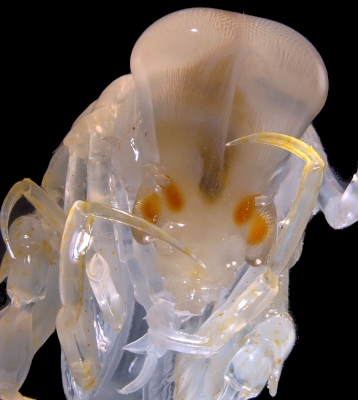
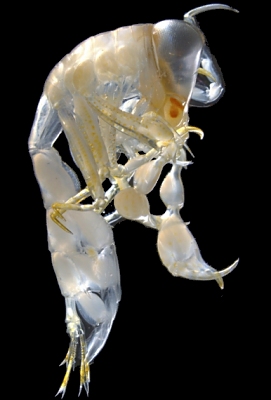
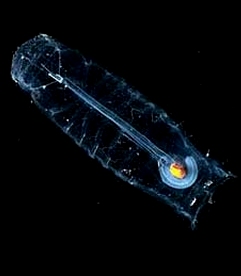
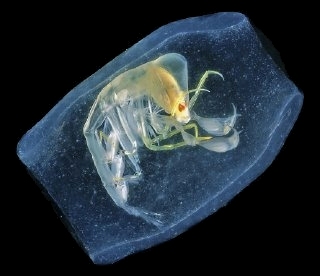
When the female Phronima is ready to lay her eggs, she hunts down the unsuspecting salp,
squeezes into its body, consumes its internal organs and cuts the outer skin into a
tube-shaped husk. This hollowed out carcass serves as a mobile nursery to house the
eggs, a steady source of food for the developing young and even a disguise for ambushing
live prey, which the mother pulls into the salp with her long, hooked claws.
squeezes into its body, consumes its internal organs and cuts the outer skin into a
tube-shaped husk. This hollowed out carcass serves as a mobile nursery to house the
eggs, a steady source of food for the developing young and even a disguise for ambushing
live prey, which the mother pulls into the salp with her long, hooked claws.
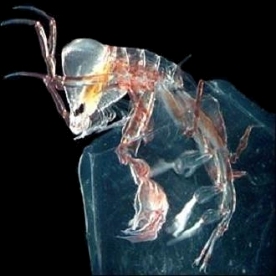
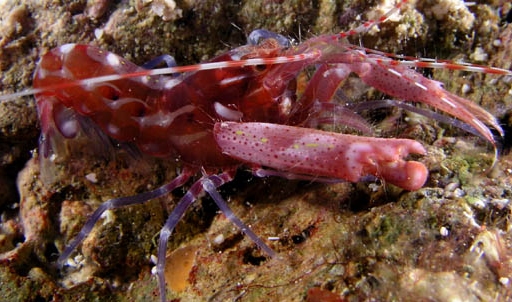
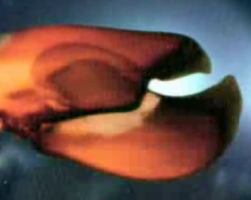
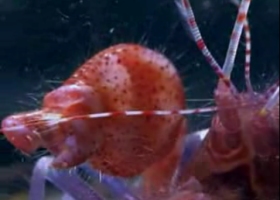
Of particular interest to zoologists are the Stomatopod's incredible sense of vision, with
some species possessing the most complicated and sophisticated eyes of any animal
known to man. While the human eye has only three visual pigments - red, green and blue -
Stomatopods may possess as many as ten, giving them a full range from infrared to
ultraviolet and hues inconceivable to the human brain. Further, they are the only animals able
to perceive circularly polarised light, which would impress the hell out of you if I took another
paragraph or four to explain what that is.
some species possessing the most complicated and sophisticated eyes of any animal
known to man. While the human eye has only three visual pigments - red, green and blue -
Stomatopods may possess as many as ten, giving them a full range from infrared to
ultraviolet and hues inconceivable to the human brain. Further, they are the only animals able
to perceive circularly polarised light, which would impress the hell out of you if I took another
paragraph or four to explain what that is.
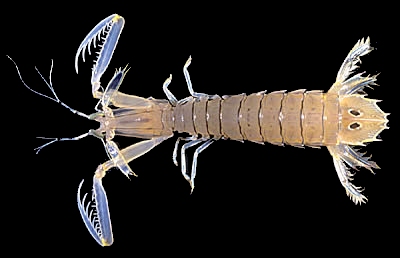
Endearingly, these fearsome little aliens are usually monogamous, and may spend up to
twenty years in male/female pairs that alternate between hunting and protecting the nest.
twenty years in male/female pairs that alternate between hunting and protecting the nest.
What all this means is that these animals are able to communicate with one another
through color patterns no other animal can fully perceive, and species that appear
completely white, black or brown to our eyes are an otherworldly rainbow to members their
own kind.
through color patterns no other animal can fully perceive, and species that appear
completely white, black or brown to our eyes are an otherworldly rainbow to members their
own kind.
| Written by Jonathan C. Wojcik - Photo credits unknown or from public news outlets. |
Sir David Attenborough of the BBC called Phronima an inspiration for the film Alien, but
wasn't speaking literally. H. R. Giger's famous movie monster actually borrows its life cycle
from Parasitoid wasps and its distinguished head-shape from a penis (and my
pageviews hereby triple) ...Giger had been painting similar creatures since much earlier in
his career, and photographs of Phronima were virtually non-existent until more recent years.
wasn't speaking literally. H. R. Giger's famous movie monster actually borrows its life cycle
from Parasitoid wasps and its distinguished head-shape from a penis (and my
pageviews hereby triple) ...Giger had been painting similar creatures since much earlier in
his career, and photographs of Phronima were virtually non-existent until more recent years.
| Photos: Pål Abrahamsen, IMR. |
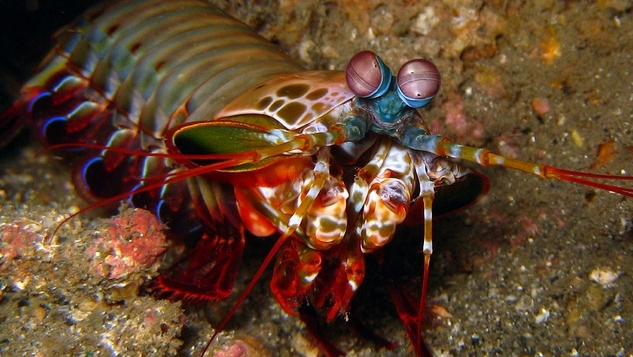
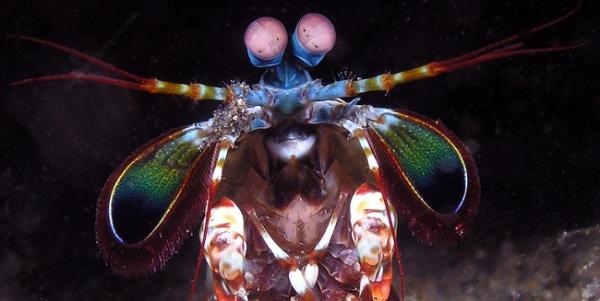
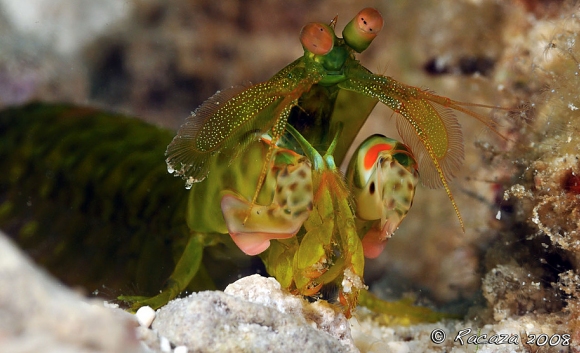
| Photo by Daniel Kwok |
| Photo by Raymond |
| Photo by Doug Deep |
Since being nature's blaster rifle apparently wasn't cool enough for these guys, at least one
species is also eusocial; the colonial lifestyle generally shared only by ants, bees, termites
and mole-rats. The queen shrimp makes her home within the catacomb-like innards of a
living sea sponge, producing an army of sterile soldiers who wield their pistols en-masse to
protect their living hive from sponge-eating worms, fish and other interlopers. The larger
queens actually lack pistols of their own, but with so many armed guards, why bother?
species is also eusocial; the colonial lifestyle generally shared only by ants, bees, termites
and mole-rats. The queen shrimp makes her home within the catacomb-like innards of a
living sea sponge, producing an army of sterile soldiers who wield their pistols en-masse to
protect their living hive from sponge-eating worms, fish and other interlopers. The larger
queens actually lack pistols of their own, but with so many armed guards, why bother?
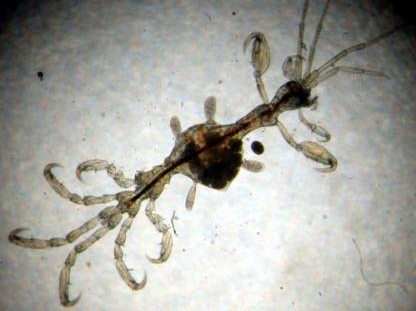
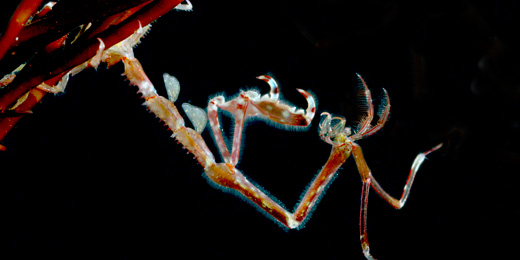
Named for their resemblance to a pile of bones, the Skeleton Shrimp or Caprellidae fill the
exact same ecological niche as the Preying Mantis of the land; with their thin, branchlike
bodies, they blend in with the surrounding foliage (or foliage-like animals) and wait
motionless for prey to swim within reach of their hook-like claws. Though rarely more than
an inch in length, thousands of them may cling to a single sponge or coral, creating a killer
forest of invisible claws.
exact same ecological niche as the Preying Mantis of the land; with their thin, branchlike
bodies, they blend in with the surrounding foliage (or foliage-like animals) and wait
motionless for prey to swim within reach of their hook-like claws. Though rarely more than
an inch in length, thousands of them may cling to a single sponge or coral, creating a killer
forest of invisible claws.
Caprellids twist the anatomy of a Crustacean into a fairly unusual structure. The legs at the
back are used only for anchoring the animal in place. The legs up front are used for capture
and the paddles in between can help the creature swim. They usually move by alternately
grasping with the front and back end, exactly like an inchworm.
Unlike the greatly exaggerated bedroom habits of the mantis, the females of some
Caprellid species cannibalize the male as a normal part of the mating ritual, injecting him
with venom from a specialized claw.
back are used only for anchoring the animal in place. The legs up front are used for capture
and the paddles in between can help the creature swim. They usually move by alternately
grasping with the front and back end, exactly like an inchworm.
Unlike the greatly exaggerated bedroom habits of the mantis, the females of some
Caprellid species cannibalize the male as a normal part of the mating ritual, injecting him
with venom from a specialized claw.
| Remipedes |
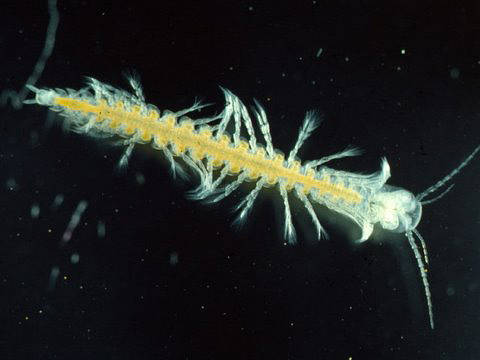
Remarkably similar-looking but completely unrelated to centipedes, the Remipedes are
their own unusual group of Crustacean first discovered in 1979. Thus far, all species are
found exclusively in underwater caves around the world, isolated so far from one another
that they must have been quite common in ancient seas before changing conditions drove
them deeper into the Earth. Now heavily adapted to the darkness, these colorless and
eyeless creatures use an array of feelers to hunt for small prey, and like centipedes, carry a
potent venom in a set of fang-like claws near the head.
Though only a few centimeters in length, some Remipedia have been named after famous
giant monsters, including the genera Pleomothra (swimming Mothra) and the species
Godzillius robustus (strong Godzilla).
their own unusual group of Crustacean first discovered in 1979. Thus far, all species are
found exclusively in underwater caves around the world, isolated so far from one another
that they must have been quite common in ancient seas before changing conditions drove
them deeper into the Earth. Now heavily adapted to the darkness, these colorless and
eyeless creatures use an array of feelers to hunt for small prey, and like centipedes, carry a
potent venom in a set of fang-like claws near the head.
Though only a few centimeters in length, some Remipedia have been named after famous
giant monsters, including the genera Pleomothra (swimming Mothra) and the species
Godzillius robustus (strong Godzilla).
| photo © Jill Yager, Antioch College |